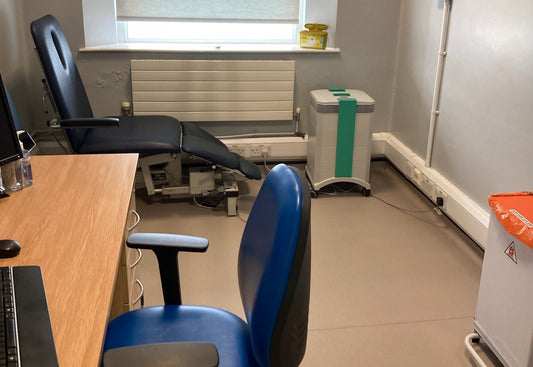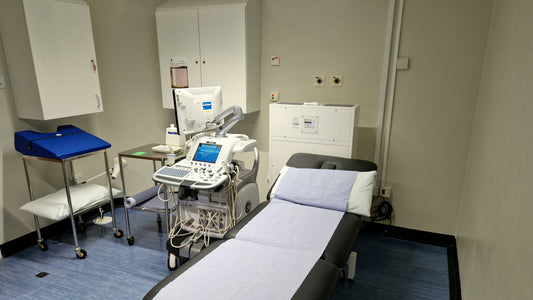Ventilation is an important component in infection prevention and control, specifically in the management of airborne infection.1 Depending on the level of air pollution (both indoor and outdoor), the right air filtration system can help reduce indoor air pollution and its negative effects on human health.
In hospital facilities, ensuring good air quality control is essential not only for infection prevention, but also for the optimal health, productivity, and well-being of healthcare workers.2
In recognising the disparity in facilities and performance around the UK, new NHS guidelines for HEPA filter devices are now in place to ensure hospitals and other healthcare settings have the right specifications and standards in place when choosing an environmental air filtration solution. While we welcome this much-needed guidance, there are a few things we wish the guidance would take into consideration as part of the recommendation of HEPA filter devices for hospital settings.
The first of which is the case of filter efficiency.
The NHS guidelines recommend the use of local HEPA filter-based air cleaners as a key option for supplementing and improving ventilation - which can significantly reduce the risk of airborne transmission.1 In particular, the guidance recommends the use of HEPA-filtered devices that are classified as BS EN 1822-1 or ISO 29463-1, with a filter efficacy of 99.95% (H13 filter) or 99.995% (H14 filter).1
As we know, a high filtration efficiency and adequate number of air changes will reduce the number viral and bacterial contamination in the air in a closed setting.3 The number of air changes required varies with the activity in an area; a highly sterile environment, such as operating theatres, requiring as many as 25 air changes per hour is now standard.3
Local HEPA filter devices use fan-assisted circulation to pull contaminated room air into the device, pass it through the filters and then reintroduce the cleaned air into the room. With the need to achieve an appropriate number of air changes, and the requirement of high filtration efficiency of H13, manufacturers have to resort to high-speed fans and dense filters but are thus limited in regard to what can be achieved in sound pressure levels. The reliance on high filtration efficiency filters increases the resistance and friction of air as it passes through the filter, affecting the sound pressure and thus making units difficult to use in certain hospital environments.
Therefore, it is crucial to strike the perfect balance between high filtration efficacy, high airflow, and the appropriate sound pressure levels when selecting an air filtration system. While the recent guidance recommends H13 and even H14 filters, independent tests show that they are not the only filter grades that can effectively and quickly clean the air in an indoor environment.
Filters that are less dense - such as H11 - will have a lower filtration efficiency, generate lower sound pressure levels, and provide a higher level of airflow. Thus, a HEPA filtered device fitted with H11 filters will have a higher single pass rate for particles, their overall performance in reducing particulate contamination in a given room can be as high as a device fitted with higher density filters - but at lower sound pressure levels. Therefore, it is in our opinion important to consider the appropriate units fitted with H11 filters when choosing a filtration system for noise sensitive hospital environments.
Furthermore, the guidance also notes that devices with low-grade filtration, which are not able to filter microorganisms at a relatively high filtration efficiency, are not recommended in settings with vulnerable patients. Devices which can produce unwanted by-products due to the use of ionisation, photocatalytic oxidation, electrostatic precipitation or other similar technologies by themselves or alongside HEPA filters are also not recommended for healthcare use at all unless there is clear evidence for both effectiveness and safety.1
Did you know?
HEPA filters comprise of porous structure of fibres or membranes which remove particles carried in an air stream.1They can remove virtually all particulate pollution, including viruses, bacteria, ultra-fine dust, pollen. A particulate filter's efficiency is measured at particle size of 0.3 μm - as it is the 'most penetrating' and thus most difficult to capture range of particulates.4

Image from: G.J. Curiel, H.L.M. Lelieveld, in Encyclopedia of Food Microbiology (Second Edition), 2014
The mechanism by which particles are removed depends on the size of the particle.1
Larger particles are removed by impaction onto the filter while smaller particles <1 μm are removed through interception and diffusion. Interception occurs where the particle makes physical contact with the media fibres because particle inertia is not strong enough to enable the particle movement to continue.1
Diffusion is where the random motion (Brownian motion) of the particle enables it to contact the media. This is important for healthcare facilities because it stops the smallest particle types like viruses from getting through. These effects are enhanced by the electrostatic charges present in filters.1
Providing the appropriate number of air changes of clean air to sensitive areas through existing ventilation systems can be challenging. Commercial Air Filtration helps hospital environments meet their airborne hygiene needs with the use of standalone HEPA hospital air filtration systems.
Studies have shown that the use of HEPA filtered devices can significantly reduced the environmental MRSA contamination within the patient rooms (75% to 93%)5 and reduced the rate of invasive aspergillosis infections by 50%.5These systems also enabled hospitals to realise significant cost savings, proving the use of IQAir portable HEPA units to be a very cost-effective strategy.6
We work within the NHS guidelines and with Infection Control Teams and Facilities Managers to specify the optimum installation for each healthcare environment. For more information, please call 0203 176 0524 or email us at info@CommercialAirFiltration.co.uk.
*For a discussion of the efficacy of UVC air cleaners, please see: https://commercialairfiltration.co.uk/blogs/news/uvc-air-cleaners-their-efficacy.
Reference:
- NHS: NHS Estates Technical Bulletin (NETB 2023/01A): application of HEPA filter devices for air cleaning in healthcare spaces: guidance and standards. Available at: https://www.england.nhs.uk/long-read/application-of-hepa-filter-devices-for-air-cleaning-in-healthcare-spaces-guidance-and-standards/#executive-summary. Last accessed: November 2023.
- Ibrahim F, Samsudin EZ, Ishak AR, Sathasivam J. Hospital indoor air quality and its relationships with building design, building operation, and occupant-related factors: A mini-review. Front Public Health. 2022;10:1067764.
- Humphreys H. Infection prevention and control considerations regarding ventilation in acute hospitals. Infect Prev Pract. 2021;3(4):100180.
- Environmental Protection Agency. Hepa Filters. Available at: https://www.epa.gov/indoor-air-quality-iaq/what-hepa-filter. Last accessed: November 2023.
- Boswell TC, Fox PC. Reduction in MRSA environmental contamination with a portable HEPA-filtration unit. J Hosp Infect. 2006;63(1):47-54.
- Abdul Salam ZH, Karlin RB, Ling ML, Yang KS. The impact of portable high-efficiency particulate air filters on the incidence of invasive aspergillosis in a large acute tertiary-care hospital. Am J Infect Control. 2010;38(4):e1-e7.




